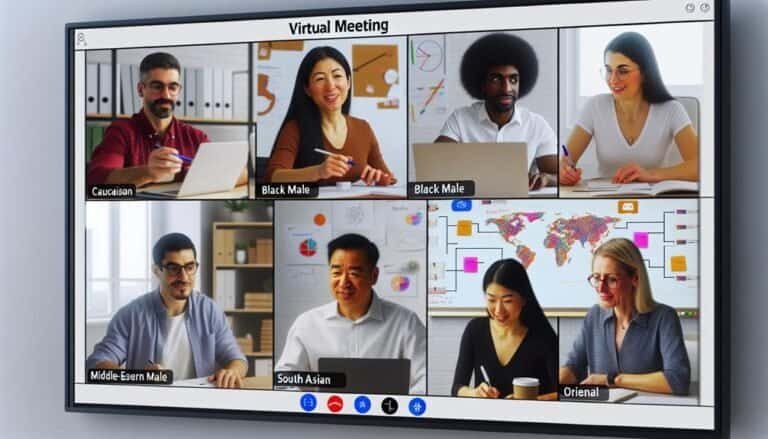Time Management Tips for the Remote Professional
In today's fast-paced and dynamic work environment, remote professionals face unique challenges when it comes to managing their time effectively. The transition to remote work has blurred the lines between personal and professional life, making it crucial to establish clear boundaries and routines.
However, this is just the tip of the iceberg when it comes to mastering time management in a remote setting. With the increasing prevalence of remote work, it's imperative for professionals to optimize their workspace, prioritize tasks, and utilize effective communication strategies to stay on top of their game.
But that's not all – there are several other key aspects to consider when it comes to time management as a remote professional.
Key Takeaways
- Set clear boundaries and establish routines to maintain work-life balance.
- Optimize your workspace for better focus and productivity.
- Prioritize tasks and goals based on urgency and importance.
- Utilize effective communication strategies to enhance collaboration and understanding.
Setting Boundaries and Routines
Establishing clear boundaries and consistent routines is essential for remote professionals to maintain a healthy work-life balance and productivity. When working from home, it can be challenging to separate professional and personal life, leading to burnout and decreased efficiency.
To combat this, remote professionals should set clear boundaries with their working hours, family members, and housemates. Communicating these boundaries effectively can help create a conducive work environment and minimize distractions.
Moreover, creating a daily routine can significantly improve time management and productivity. Start by designating specific work hours, taking regular breaks, and adhering to a structured schedule. This helps in maintaining focus during work hours and allows for ample relaxation during personal time.
It is equally important to establish a dedicated workspace within the home environment. This physical boundary helps in signaling the start and end of the workday, mentally separating professional and personal life.
Optimizing Your Workspace
To ensure optimal productivity and a conducive work environment, remote professionals must carefully curate and organize their workspace. This involves creating a space that promotes comfort, focus, and efficiency. Here are some key elements to consider:
- Ergonomic Furniture: Investing in a quality ergonomic chair and desk can significantly impact your physical well-being and productivity. Properly adjusted furniture can help prevent discomfort and fatigue, allowing you to maintain better focus throughout the day.
- Natural Lighting: Positioning your workspace near a natural light source can help reduce eye strain and improve mood. Access to natural light is essential for maintaining a healthy circadian rhythm and enhancing overall well-being.
- Minimalist Design, Personalized Touches: Embracing a minimalist design can help reduce visual clutter and create a calming atmosphere. Additionally, adding personalized touches such as artwork, plants, or meaningful decor can make your workspace feel more inviting and inspiring.
Prioritizing Tasks and Goals
When managing tasks and goals as a remote professional, effective prioritization is essential for maximizing productivity and achieving desired outcomes. One effective technique for prioritizing tasks and goals is time blocking, which involves dedicating specific time slots to focus on particular tasks or goals. This method helps in avoiding distractions and ensures that important tasks are given the necessary attention. Another crucial aspect of task prioritization is understanding the urgency and importance of each task. By categorizing tasks based on these factors, remote professionals can allocate their time and resources more efficiently.
| Urgent & Important | Important, Not Urgent | Urgent, Not Important | Not Urgent & Not Important |
|---|---|---|---|
| Task 1 | Task 2 | Task 3 | Task 4 |
| Task 5 | Task 6 | Task 7 | Task 8 |
| Task 9 | Task 10 | Task 11 | Task 12 |
Utilizing these methods of task prioritization enables remote professionals to stay organized, focused, and on track to accomplish their goals, ultimately leading to increased efficiency and productivity.
Effective Communication Strategies
In order to excel as a remote professional, effective communication strategies are paramount. Clear and concise messaging ensures that information is conveyed accurately and efficiently.
Active listening skills and the use of video conferencing further enhance communication, fostering collaboration and understanding among remote teams.
Clear and Concise Messaging
Crafting clear and concise messages is essential for effective communication in a remote professional setting. When it comes to email etiquette, it's crucial to use clear subject lines, keep the message concise, and proofread for clarity before hitting send.
Instant messaging etiquette demands prompt responses, the use of appropriate language and tone, and the avoidance of ambiguous or lengthy messages.
Clear and concise messaging helps remote professionals convey their thoughts and ideas effectively, minimizing the risk of misunderstandings and saving time for both the sender and the recipient.
Active Listening Skills
Effective communication in a remote professional setting extends beyond clear and concise messaging; it also requires honing active listening skills to foster meaningful and productive interactions. Improving focus and enhancing engagement are essential aspects of active listening. Remote professionals can benefit from actively listening to their colleagues and clients, as it helps in understanding their perspectives, needs, and concerns more effectively. To emphasize the importance of active listening, consider the following table:
| Benefits of Active Listening | ||
|---|---|---|
| 1. Improved Understanding | 2. Enhanced Collaboration | 3. Strengthened Relationships |
Utilize Video Conferencing
Utilizing video conferencing as a tool for communication allows remote professionals to engage in real-time, interactive discussions, fostering a sense of connectivity and collaboration among team members and clients. This technology significantly contributes to improving engagement and building rapport in the following ways:
- Facial Expressions: Video conferencing allows participants to observe facial expressions, promoting better understanding and empathy during conversations.
- Body Language: It enables the interpretation of body language cues, enhancing the overall communication experience and fostering a more natural interaction.
- Visual Content Sharing: The ability to share visual content in real-time facilitates clearer explanations, leading to improved comprehension and engagement among all participants.
Utilizing Time-Tracking Tools
An essential aspect of effective time management for remote professionals involves the consistent use of reliable time-tracking tools to monitor and optimize productivity. Utilizing time-tracking software is crucial for improving productivity and remote work efficiency. It allows professionals to analyze how they allocate their time, identify inefficiencies, and make necessary adjustments to enhance their time management techniques. Below is a table displaying three popular time-tracking tools:
| Time-Tracking Tools | Description | Key Features |
|---|---|---|
| Toggl | User-friendly time tracker suitable for individuals and teams | One-click time tracking, project time estimation, detailed reports |
| Harvest | Ideal for tracking billable hours and managing project budgets | Invoicing, expense tracking, team timesheets |
| Clockify | Free time tracking software with robust features | Unlimited users, reporting, project and task management |
Balancing Work and Personal Life
Balancing work and personal life is essential for remote professionals to maintain their well-being and productivity.
Setting clear boundaries for work-life integration and scheduling personal time are crucial strategies.
Boundaries for Work-Life
Creating clear boundaries between work and personal life is essential for remote professionals to maintain a healthy balance and avoid burnout. Setting limits and personal boundaries is crucial for a successful work-life balance.
Here are three strategies to help establish and maintain boundaries:
- Designate specific work hours and adhere to them strictly.
- Create a dedicated workspace that is separate from your living areas.
- Communicate openly with your employer, colleagues, and family about your availability and schedule.
Scheduling Personal Time
To maintain a healthy work-life balance, remote professionals must proactively allocate dedicated time for personal activities and relaxation, ensuring that work commitments do not encroach on their personal lives. Implementing self-care practices and time blocking for leisure activities and daily rituals is essential.
Remote professionals should schedule regular breaks throughout the day to engage in activities that promote relaxation and rejuvenation. Whether it's taking a short walk, practicing mindfulness, or enjoying a hobby, incorporating these moments into the daily schedule can significantly contribute to overall well-being.
Additionally, setting boundaries around work hours and adhering to them helps in separating work from personal time. By consciously planning and prioritizing personal time, remote professionals can effectively balance their professional responsibilities with self-care and leisure activities.
Conclusion
In conclusion, mastering time management as a remote professional is essential for productivity and work-life balance.
By setting boundaries, optimizing your workspace, prioritizing tasks, communicating effectively, and utilizing time-tracking tools, you can enhance your efficiency and success.
Balancing work and personal life is crucial for overall well-being. Implementing these strategies will help you thrive in your remote professional role and achieve your goals.







